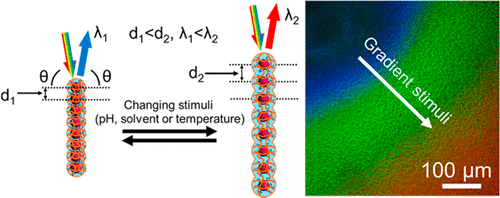当前位置:
X-MOL 学术
›
Nano Lett.
›
论文详情
Our official English website, www.x-mol.net, welcomes your
feedback! (Note: you will need to create a separate account there.)
Responsive Hydrogel-based Photonic Nanochains for Microenvironment Sensing and Imaging in Real Time and High Resolution.
Nano Letters ( IF 9.6 ) Pub Date : 2018-01-17 , DOI: 10.1021/acs.nanolett.7b04218 Wei Luo 1, 2 , Qian Cui 1 , Kai Fang 1 , Ke Chen 3 , Huiru Ma 3 , Jianguo Guan 1
Nano Letters ( IF 9.6 ) Pub Date : 2018-01-17 , DOI: 10.1021/acs.nanolett.7b04218 Wei Luo 1, 2 , Qian Cui 1 , Kai Fang 1 , Ke Chen 3 , Huiru Ma 3 , Jianguo Guan 1
Affiliation

|
Microenvironment sensing and imaging are of importance in microscale zones like microreactors, microfluidic systems, and biological cells. But they are so far implemented only based on chemical colors from dyes or quantum dots, which suffered either from photobleaching, quenching, or photoblinking behaviors, or from limited color gamut. In contrast, structural colors from hydrogel-based photonic crystals (PCs) may be stable and tunable in the whole visible spectrum by diffraction peak shift, facilitating the visual detection with high accuracy. However, the current hydrogel-based PCs are all inappropriate for microscale detection due to the bulk size. Here we demonstrate the smallest hydrogel-based PCs, responsive hydrogel-based photonic nanochains with high-resolution and real-time response, by developing a general hydrogen bond-guided template polymerization method. A variety of mechanically separated stimuli-responsive hydrogel-based photonic nanochains have been obtained in a large scale including those responding to pH, solvent, and temperature. Each of them has a submicrometer diameter and is composed of individual one-dimensional periodic structure of magnetic particles locked by a tens-of-nanometer-thick peapod-like responsive hydrogel shell. Taking the pH-responsive hydrogel-based photonic nanochains, for example, pH-induced hydrogel volume change notably alters the nanochain length, resulting in a significant variation of the structural color. The submicrometer size endows the nanochains with improved resolution and response time by 2-3 orders of magnitude than the previous counterparts. Our results for the first time validate the feasibility of using structural colors for microenvironment sensing and imaging and may further promote the applications of responsive PCs, such as in displays and printing.
中文翻译:

基于响应水凝胶的光子纳米链,可实时,高分辨率地用于微环境传感和成像。
在微反应器,微流体系统和生物细胞等微尺度区域中,微环境传感和成像至关重要。但是到目前为止,它们仅基于染料或量子点的化学颜色实施,而这些化学颜色可能会遭受光漂白,猝灭或光闪烁行为,或者会受到色域的限制。相比之下,基于水凝胶的光子晶体(PC)的结构颜色在整个可见光谱范围内可能会由于衍射峰位移而变得稳定和可调,从而有助于以高精度进行视觉检测。但是,由于体积大,当前基于水凝胶的PC都不适合进行微尺度检测。在这里,我们展示了最小的基于水凝胶的PC,具有高分辨率和实时响应的响应式基于水凝胶的光子纳米链,通过开发通用的氢键引导模板聚合方法。大规模获得了各种机械分离的基于刺激响应的水凝胶的光子纳米链,包括那些对pH,溶剂和温度有响应的纳米链。它们中的每一个都具有亚微米的直径,并且由被几十纳米厚的豆荚状的响应水凝胶壳锁定的单个磁性颗粒的一维周期性结构组成。以pH响应的基于水凝胶的光子纳米链为例,pH诱导的水凝胶体积变化会显着改变纳米链的长度,从而导致结构颜色的显着变化。亚微米尺寸使纳米链的分辨率和响应时间比以前的同类产品提高了2-3个数量级。
更新日期:2019-11-18
中文翻译:

基于响应水凝胶的光子纳米链,可实时,高分辨率地用于微环境传感和成像。
在微反应器,微流体系统和生物细胞等微尺度区域中,微环境传感和成像至关重要。但是到目前为止,它们仅基于染料或量子点的化学颜色实施,而这些化学颜色可能会遭受光漂白,猝灭或光闪烁行为,或者会受到色域的限制。相比之下,基于水凝胶的光子晶体(PC)的结构颜色在整个可见光谱范围内可能会由于衍射峰位移而变得稳定和可调,从而有助于以高精度进行视觉检测。但是,由于体积大,当前基于水凝胶的PC都不适合进行微尺度检测。在这里,我们展示了最小的基于水凝胶的PC,具有高分辨率和实时响应的响应式基于水凝胶的光子纳米链,通过开发通用的氢键引导模板聚合方法。大规模获得了各种机械分离的基于刺激响应的水凝胶的光子纳米链,包括那些对pH,溶剂和温度有响应的纳米链。它们中的每一个都具有亚微米的直径,并且由被几十纳米厚的豆荚状的响应水凝胶壳锁定的单个磁性颗粒的一维周期性结构组成。以pH响应的基于水凝胶的光子纳米链为例,pH诱导的水凝胶体积变化会显着改变纳米链的长度,从而导致结构颜色的显着变化。亚微米尺寸使纳米链的分辨率和响应时间比以前的同类产品提高了2-3个数量级。











































 京公网安备 11010802027423号
京公网安备 11010802027423号